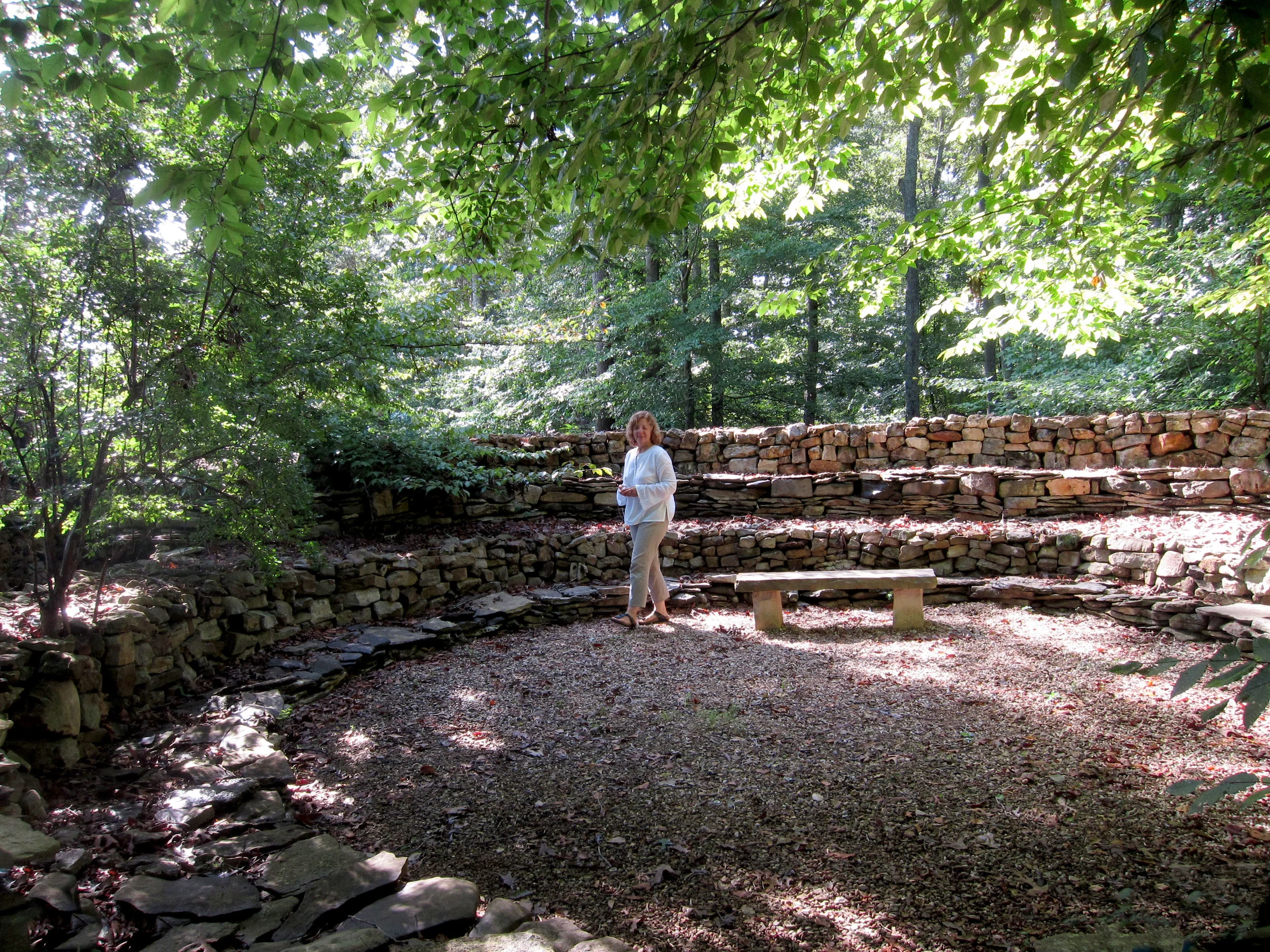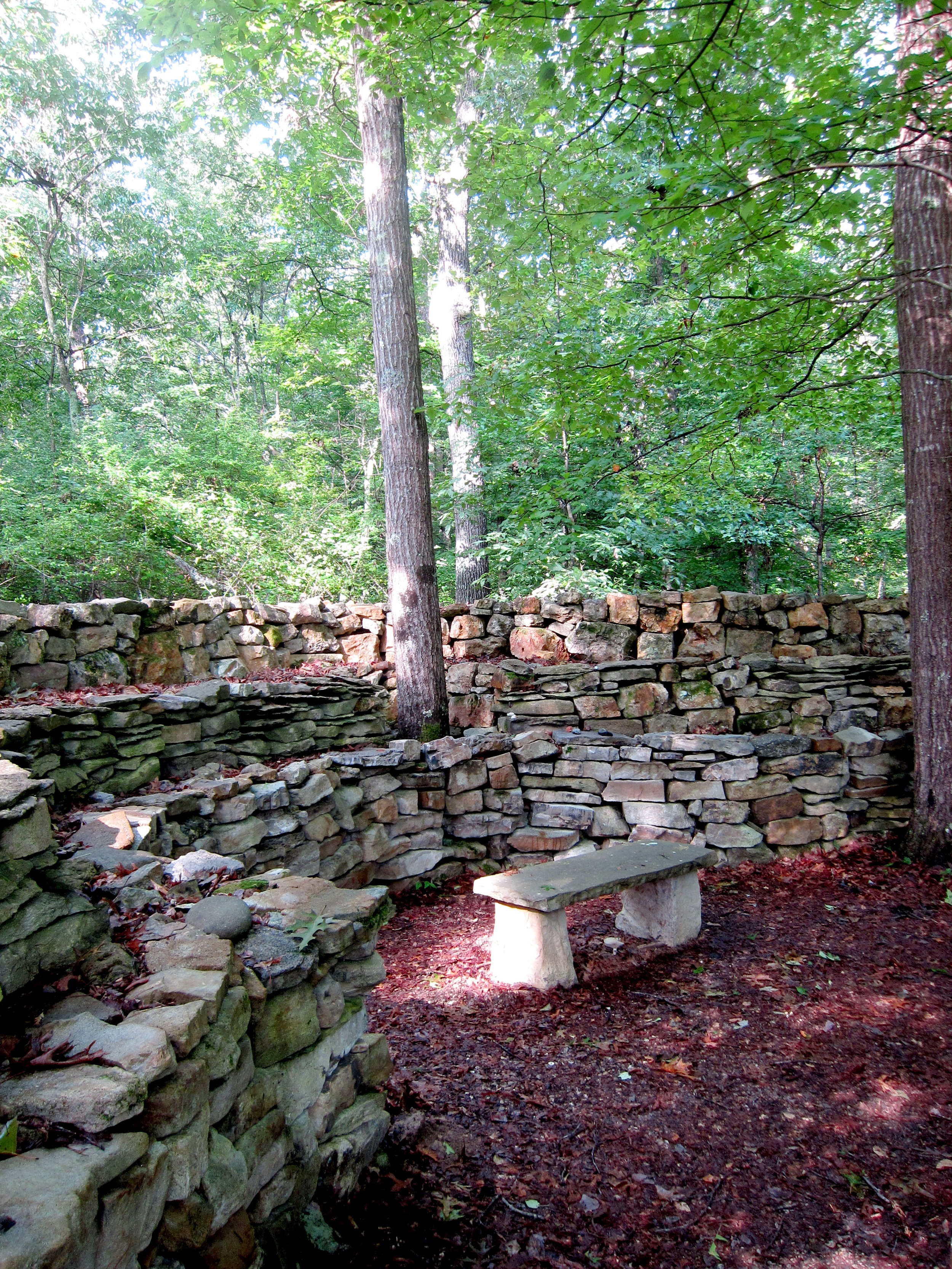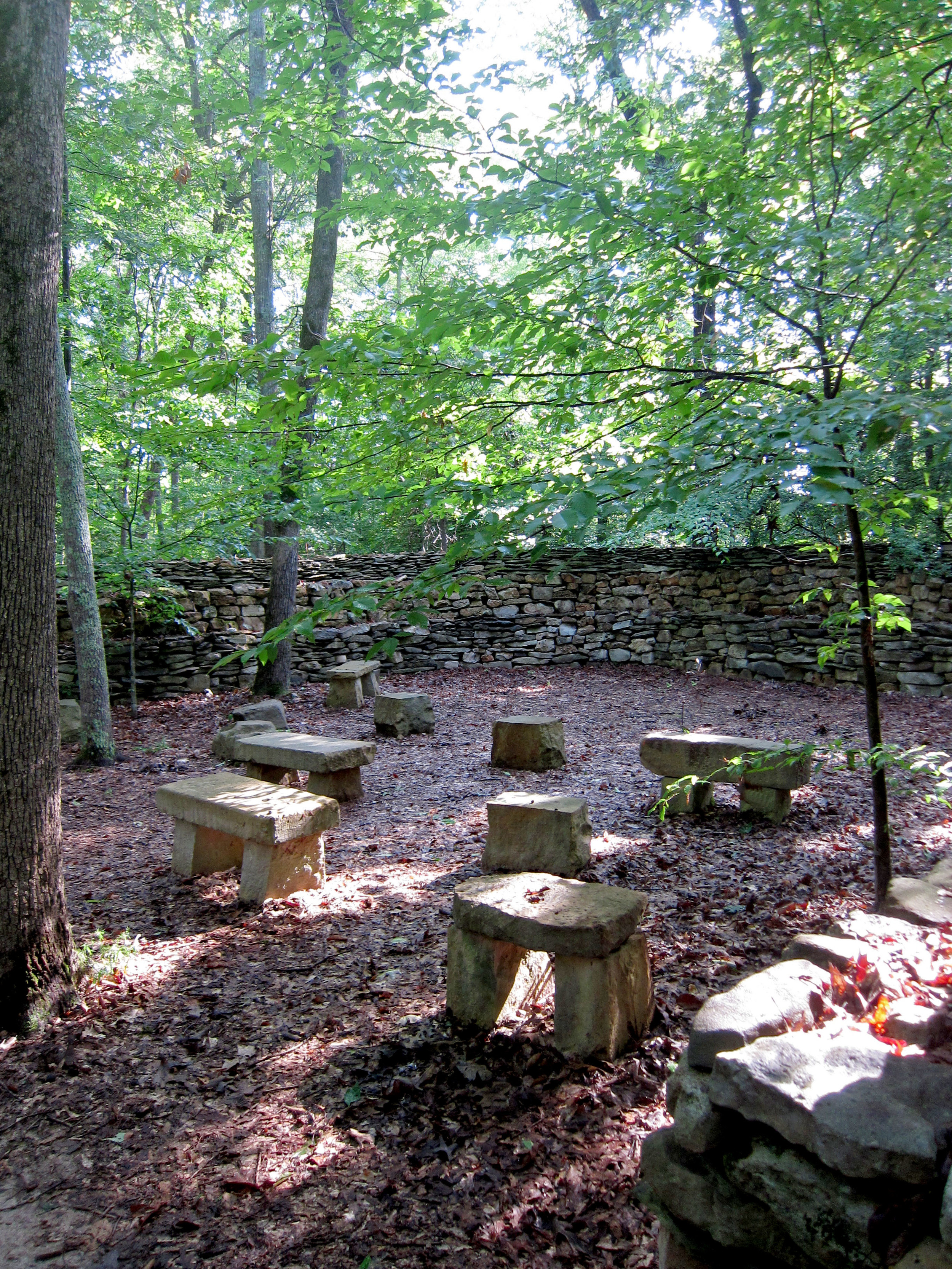The Great Wall of Alabama
Text published in Departures Magazine
Photographs by Gael Towey
Thirty years ago one man started laying down a stone for every footstep his
ancestor took on the Trail of Tears. His still-growing memorial is now one of the country’s most spectacular—and unknown—pieces of land art.
There is no sign for the Wichahpi Wall, just an inconspicuous dirt-and-gravel drive off the Natchez Trace Parkway outside Florence, in northwestern Alabama, a two-hour drive from Birmingham. The structure is nestled in the forest as if it has always been there, like an ancient ruin. It consists of two parallel walls that meander into the woodland as far as the eye can see, undulating through trees and twisting into secluded alcoves. The walls are about four feet high, built with limestone and sandstone rocks and specked with pillows of moss. Light refracts among the white and red oaks, and sweet gum and beech trees that arch overhead. The whole place seems to vibrate underfoot.
Though little known outside Florence, it is a work of spectacular scale and power, rivaling the greatest pieces of American land art, from Robert Smithson’s Spiral Jetty, on the shore of Utah’s Great Salt Lake, to Andy Goldsworthy’s 2,278-foot-long stone wall at the Storm King Art Center in New York’s Hudson River Valley. And yet those names mean little to Tom Hendrix, who began building his wall more than 30 years ago for reasons having nothing to do with art. He conceived it as a memorial to his great-great-grandmother Te-lah-nay, a Yuchi Indian healer who was swept up in the Trail of Tears in the 1830s. She was one of the millions of southeastern Native Americans driven by force to the new Indian Territories west of the Mississippi following Andrew Jackson’s Indian Removal Act. The wall is a tribute to her journey to Oklahoma and her five-year, 700-mile walk back east, with each stone representing one footstep. Hendrix, now 82, moved every stone himself. If you were to straighten it out, the Wichahpi Wall would measure 6,600 feet.
Hendrix strides to the end of his driveway and welcomes visitors with a Yuchi Indian greeting: “Aglaysaha—it’s a good day.” He is about six feet tall with wavy white hair, a friendly face, long arms and huge, well-used hands. “Of course, if you are as old as I am, every day is a good day,” he says. He grew up listening to his grand-mother tell stories about Te-lah-nay. Sitting by his Ford pickup truck with his two pit bulls, Hendrix continues that oral tradition.
Around 1985, Hendrix says, he began having a recurring dream about an Indian woman who repeatedly touched her hand to her mouth. Hendrix’s Irish wife, Doreen, suggested that it was Te-lah-nay, asking him to tell her story. That year at a Native American craft show in Lebanon, Tennessee, he met a very old Yuchi woman, one of the five remaining speakers of the Yuchi language. He told her the tale of his great-great-grandmother and expressed his desire to build a memorial. She responded, “We shall all pass this earth, Tom, but only the stones will remain.” It was his if-you-build-it-they-will-come moment.
Although Hendrix worked with his hands at the Ford Motor Company as a die caster for 20 years, he had never built a stone wall. He didn’t draw up any blueprints; he just started piling rocks and improvised as he went along, like a good storyteller. He estimates that the wall consists of nine million pounds of stone.
Many indigenous people have visited the Wichahpi Wall—wichapi is Navajo for “like the stars”—and made contributions. Eighteen years ago a Lakota man visited and suggested Hendrix add a stone circle, which the man called an ishatae, or “spiritual place.” He drew the outline on a piece of paper and Hendrix built it as designed. It has four layers of stone, each of a different design, to represent the circle of life: birth, life, death and rebirth.
I heard about The Wall from my friends Rosanne Cash, the singer songwriter and oracle of the south, and Natalie Chanin, the clothing designer whose intricately stitched and embroidered clothes are made by hand by local quilters under the name Albama Chanin. Rosanne and I introduced Maira Kalman, the author illustrator and cultural muse, to Natalie at tea in New York. The four of us resolved to meet in Florence, learn to sew with Natalie and visit The Wall. Rosanne had been to The Wall on one of her past visits to the Muscle Shoals recording studios where the famous sound of the South was born. Natalie said that “The Wall was a mysterious, eccentric and some say spiritual place” but she would not tell me more. Rosanne’s latest album, The River and The Thread, mentions her experience at The Wall in the song, “A Feather is Not a Bird.” She ends the song with this verse: “I am goin down to Florence, now I got my pretty dress, I’m gonna let the magic wall put the voices in my head.“ Rosanne told me that “when I first went to The Wall I sat in the prayer circle, expecting to take the time to concentrate and seek out the spirits that I had hear about, but instead what ever power was there, had already found me. “
Tom Hendrix opens his arms wide and faces east. “This section of the Wall represents my great-great-grandmother’s walk from her home on the Singing River to the Indian Territories in what is present day Muskogee, Oklahoma.” Her name was Tel-ah-ney and she was about 17 when she and her sister Whana-le were herded into a stockade and metal tags were put around their necks. They left Alabama in the late summer of 1836 or 1837 and walked through the fall months arriving in winter. On the grueling walk to Oklahoma, a young soldier, Lieutenant Bates, noticed the young girls and realized that Tel-ah-ney was a healer. He watched over them, protected them and became their friend. Tom has dedicated a section of the Wall to Lieutenant Bates where the rocks curve gently around a single tree and the pattern changes to thin slivers of rock that add a fragility to the massive memorial.
Tom’s great-great grandmother, Te-lah-ney was born in the Tennessee Valley in the early 1800s. The Yuchi believed that a woman lived in the Tennessee River and sang to them. The Wall meanders just as Te-lah-ney’s journey did and there are many surprises. I stopped first at a ten-foot section of the wall built with river rocks that look like faces. The “eyes” that look out at you are natural holes worn in soft limestone from centuries of bumping along at the edge of the Tennessee River. I sat on the stone bench opposite and gazed at the “faces” which were initially haunting but after a few minutes I felt curiously happy. The Lakota people who modified this section of the Wall told Tom that all bad things come out of the west, so they positioned the rock faces facing west, saying they would protect Te-lah-ney’s Wall.
When Tom conceived of his memorial to his great-great-grandmother Te-lah-nay 25 years ago, he did not start with sketches or plans. He began by picking rocks that local farmers, clearing their land of hedgerows, had dumped by the side of the road. For 28 years has kept careful track of the truckloads, and estimates that the wall consists of 9 million pounds of stone. Each stone has been touched three times: once when he selects them and places them in his pick up truck, once at home when he unloads them into his wheelbarrow, and once when he positions each rock in The Wall. By his count, he has lifted 27 million pounds of stones, gone through three pick-up trucks, 22 wheelbarrows, and 3,900 pairs of gloves. He believes he must hold the world record for mashed fingers.
Like most folk art, Tom’s construction is rooted in history and shaped by cultural memory—although it was paradoxically created in total isolation. Kelly Wacker, a university art history professor who specializes in research about land art, heard about The Wall seven years ago and has since become a friend of Tom’s. She feels that Te-lah-ney’s Wall has aspects of both traditions: outsider art and environmental art. “Outsider art is created by someone who is compelled to execute a personal vision,” she says. “Tom is telling a story in a physical way and creating a monument to a place of memory.”
“At one time the Indians of the Southeast had the healing and practical knowledge of over 1,000 plants,” says Jason Baird Jackson, Director of the Mathers Museum of World Cultures at Indiana University. Healers, like Te-lah-ney, were selected from the tribe for their skill at diagnosing ailments, recognizing and processing the plants, and singing the 1,000 songs that made the plants active as medicines.
Hendrix’s work cannot be hung on a wall; it requires a pilgrimage. The journey is part of the experience. Many indigenous people have visited the Wichapi Wall—wichapi is Navaho for “like the stars”—and made contributions. Eighteen years ago a Lakota man visited Hendrix and suggested he add a stone circle, which the man called Ishatae or Spiritual Place. He drew the outline on a piece of paper specifying its dimensions and position, east to west to take advantage of the changing seasons. It has four layers of stone, each of a different design, to represent the circle of life: birth, life, death and re-birth.
It is best to walk alone when you are at The Wall so you can feel the light and approach each twist and turn with a sense of mystery. Tom’s passion and spirit has transformed an ephemeral journey into a living memory. Sunlight on stones worn over time have an innate life that the human spirit responds to. As we move toward the path to make our own discoveries, Hendrix says, “I have only one request: look with your third eye,” and he pats his heart.








